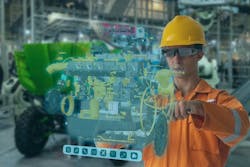Raising GenAI and Big Data Past Buzzword Status
What You’ll Learn:
- How generative AI and big data are reshaping design, automation and manufacturing workflows.
- Why cybersecurity, data ownership and governance are critical in AI-powered environments.
- What steps organizations must take to strategically implement AI tools without compromising control or quality.
Generative artificial intelligence (GenAI) seems like a recent, innovative concept, offering new perspectives on what is meant by “big data.” Despite roots that extend back through decades of computing progress, most industries have barely scratched the surface of GenAI’s capabilities. Among those industries are the automation and controls sectors, where GenAI and big data are common jargon.
In these sectors, however, the standard is quickly changing. With technologies such as smart sensors and edge computing, GenAI and big data could soon come full circle as software manufacturers increasingly build their programs around these tools. As utilization grows, cybersecurity regulatory changes and concerns will likely become more pronounced, causing many stakeholders to adjust their processes and product development. But this won’t be as easy as “flipping a switch.” Today’s organizations will need a structure to integrate these tools effectively.
Historical Perspective of Big Data and AI in Machine Design
Big data emerged in machine design by introducing smart sensors and manufacturing execution systems. These early systems focused on collecting and displaying operational information, enabling facilities to track production lines, pass/fail rates and identify potential areas for improvement. The primary goal was to make complex operational data meaningful and accessible to operators, maintenance personnel and management.
When ChatGPT became widely available in late 2022, applications for GenAI in machine design were limited but quickly took root in code generation and reporting areas. Over the past few years, these technologies have become closely intertwined with AI’s ability to interpret unstructured data and quickly identify patterns, making AI a natural fit for guiding big data strategies. Together, they’re driving more transformative change.
READ MORE: AI Gains Physical Intelligence and Transforms Robotics & Automation Design
GenAI complements physics-based modeling by simulating design scenarios, enhancing prototyping and reducing time to market. For example, in aerospace, GenAI is already paired with domain-specific AI to improve part design and optimize manufacturing processes, an approach gaining traction across industries.
While GenAI was the first to capture wide attention, the term has become a catch-all term for a broader range of AI technologies. In reality, GenAI is part of a much broader ecosystem of AI technologies used in design environments, including machine learning and neural networks, which enable more proactive applications such as predictive equipment maintenance and defect detection in production.
Technological Advancements and Use Cases in Controls and Software
AI is becoming a powerful companion in engineering and software development, supporting rather than replacing human expertise. In addition to speeding up code generation, AI is also used as a design standard and compliance assistant. By configuring an AI model with specific projects or coding guidelines, it can review code in real time, identifying deviations from established standards and suggesting modifications. This capability ensures greater consistency and quality in software and design development, helping teams efficiently comply with detailed standards.
In another use case, vision systems powered by AI transform quality control in manufacturing, automatically developing pass/fail requirements and detecting subtle variations that might escape human inspection. These systems analyze complex visual data precisely and consistently, significantly reducing human error and improving overall product quality.
AI technologies also dramatically enhance documentation and knowledge management. Machine learning-based documentation tools now generate contextual comments within code, create comprehensive operations and maintenance manuals, and provide detailed documentation that facilitates future troubleshooting and maintenance. This approach ensures critical knowledge is captured and transferred more effectively across engineering teams.
Cybersecurity and Data Privacy Challenges
AI tools are data-hungry technologies that raise significant concerns about ownership, control and protection. As manufacturers feed vast datasets into these systems—often cloud-hosted ones—they risk losing oversight, as third-party models could absorb and reuse proprietary information. Cloud-based AI often removes sensitive data from an organization’s direct control, increasing risks of misuse or intellectual property (IP) loss.
This has elevated questions of data ownership from a compliance issue to a board-level concern. Now, it is crucial for industrial organizations to make strategic decisions, such as how much data they are willing to share and with whom, especially in cloud environments, where proprietary design files or operational data may unintentionally train external AI models.
READ MORE: Just-in-Time Insights: The Factory Reset that Global Manufacturing Needs
Other decisions include who owns the outputs when sensitive information contributes to an AI’s development and whether proprietary data was embedded in a model that others can now access. The potential loss of data ownership is no longer hypothetical: It’s a real and pressing risk that organizations must actively manage.
Sensitive industries, especially those involved in managing export-controlled projects, face even greater challenges in implementing external AI models that require data sharing. Using cloud-based AI can mean surrendering control or ownership of highly sensitive operational or design data. Some organizations invest in private clouds or edge computing to keep sensitive data close to the source. Local AI processing allows manufacturers to maintain control, although it comes at a high cost that is not feasible for many.
Increasing connectivity introduces another layer of concern: vulnerability. As more digital infrastructure becomes integrated with physical assets, cybersecurity rises to a business-critical layer of IP asset protection. Each sensor, control node and endpoint becomes part of a larger attack surface. That means expanded entry points for breaches that could lead to ransomware attacks or data leaks in complex manufacturing environments.
As AI technology use increases, the systems’ digital footprints grow, and so must the protection perimeter. IP asset protection against AI cybersecurity risks is now a strategic, operational decision, not just an IT concern.
Even when systems operate without breaches, governance remains unclear. Where does accountability lie if an AI tool makes an inaccurate recommendation based on flawed data? Handing over design authority without retaining human oversight raises ethical and operational questions that governance frameworks are only beginning to address. Isolated tools or one-time audits are not meaningful safeguards against any security risks.
Strong AI cybersecurity requires continuous, deliberate review of layered strategies that evolve alongside the technology and the business. Regular security reviews allow for building resilient systems that enable innovation to scale responsibly.
Infrastructure and Strategic Implementation of AI technologies
Effective AI adoption in manufacturing begins with a focused, purposeful intent instead of implementing the newest AI tool that is receiving much attention. Defining clear, measurable objectives before selecting technologies lowers the risk that AI efforts become costly experiments with little return.
Once objectives are defined, the next step is understanding the data landscape. An honest audit of available data and its sources, structure and reliability helps determine whether current systems can support the intended AI applications. The data audit can also identify any gaps or manual workarounds needed to clean data before it can be used. Poor-quality or fragmented data limits the effectiveness of AI tools.
Infrastructure readiness is equally critical for data-intensive AI technologies. Many organizations will find that their current systems—especially older controllers, sensors or data processing platforms—may not be equipped to handle the increased data acquisition demands of AI tools. Enhancing these capabilities might involve replacing sensors, upgrading controllers or investing in new servers. These improvements can be costly, particularly if local processing is required to protect sensitive data.
READ MORE: Business Intelligence: PMMI Contextualizes the Place for Artificial Intelligence
A phased approach to implementation helps manage risk and investment. Start with small, defined use cases, such as expanding current reporting tools or automating a specific process. A modest, controlled pilot project will require minimal system overhaul, allowing organizations to test and scale without unnecessary disruption. A phased approach creates momentum and ensures alignment between technical readiness and business outcomes.
Rather than aiming to revolutionize operations overnight, successful AI strategies begin with a deliberate, layered rollout. As infrastructure is updated in tandem with capability, human oversight remains in place to guide implementation and refinement.
From Buzzwords to Action: Turning Potential into Practice
AI tools and big data are becoming foundational technologies in machine design. Broader application of their various use cases will fundamentally change how engineers approach their work. Using high-level virtual models that enable design iterations before physical construction will become standard.
Additionally, embedding neural processing units alongside programmable logic controllers (PLCs) for real-time pattern recognition will become standard practice. AI technologies, well beyond GenAI, will increasingly be integrated into engineering and manufacturing workflows. Yet, the path forward isn’t entirely clear.
It’s vital for designers and manufacturers to take a thoughtful, deliberate approach to expanding their use of AI, balancing innovation with their cybersecurity posture, infrastructure readiness and clear strategic objectives. Organizations that approach these technologies purposefully, rather than chasing trends, will be best positioned to turn these buzzwords into competitive assets while mitigating the associated risks.
About the Author

Eric Headington
Engineering Manager, Instrumentation and Controls, ACS
Eric Headington is the manager of the Instrumentation and Controls Group at ACS.

Dan Idzikowski
Senior Staff Engineer, Instrumentation and Controls, ACS
Dan Idzikowski is a senior staff engineer in the Instrumentation and Controls Group at ACS.
